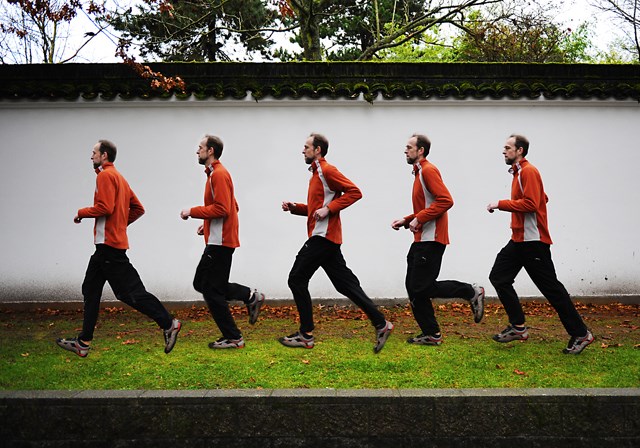In his ongoing running tour of Vancouver’s neighbourhoods, Yggy King has dipped his fingers in the Fraser River and the Burrard Inlet. He’s jogged 111-year-old train tracks, discovered a vertical playground near an industrial thoroughfare and scuttled across a rocky shore to reach the water.
The 44-year-old father of two lives in Riley Park and has run the perimetre of nine distinct neighbourhoods, logging 111.8 kilometres in his self-directed circuit that has so far taken him around Oakridge, Kensington and Mount Pleasant. When he’s circled them all, King will have run around at least 22 neighbourhoods.
“Running the neighbourhood gives you a good sense of the topography, so you learn where the valleys and hills are that you don’t appreciate in a bike or car,” said King, who, in July, started running 30 minute three times a week and on Dec. 7 completed his first cross-country race at Jericho Beach Park.
His first destination was Sunset, which he decided to run around Oct. 26 after he’d read the Courier’s neighbourhood profile in the .
“The first one was spur of the moment,” he said. “It was morning. I was flipping through the newspaper and saw the map, saw the boundary and thought that looked about the right distance.”
He made his way south along Inverness Street, avoiding the congestion on Knight St., then crossed South East Marine Drive toward industrial lots and warehouses. He jutted even farther south off Crompton Street to cross the rocky shore and reach the Fraser River. His entire route — including the out-and-back path along the beach — because King traced his route using Strava, a geolocating app on his smartphone. Once he returned home, he’d covered 12.9 km and nearly 100 meters elevation down and then back up. He posted the details on a Facebook group he started, .
“Having done one, I started thinking I could do all of them,” said King, a software engineer who moved to Â鶹´«Ă˝Ół»in 1990.
The map itself is a sign of his accomplishments and a symbol that motivates him. After his neighbourhood tour, King said he might run routes that, when seen in Strava or Google, appear to draw pictures on city maps. He calls this "cartograffiti" and the image is also known as a 21st century ".”
“It’s energizing to see the progression this way and also to challenge myself to get out a bit further,” he said. “If I just run the same route every week, it’s all the same and is a little too routine that way and means it’s more likely I’ll get bored.”
His longest run totalled 17.1 km because he didn’t just circle Arbutus Ridge but ran there from his home near Queen Elizabeth Park. (And he took along a hand-sketched map to keep his bearings.) He’s checked off all the neighbourhoods in the centre of the city — Sunset to Strathcona — because they’re accessible. When he heads to Dunbar or Hastings Sunrise, he may not get there on foot.
“As I get further afield, I may have to stat cycling to get to the beginning of my run.”
He finds corners of the city he didn’t know existed and other places he vows to return to, like the abandoned train tracks in the Arbutus Corridor, and posts his finds from the Courier and his own runs online. For example, he asked his followers, “Did you know only one third of the people in Kensington speak English as their first language?”
Covering new terrain is a powerful incentive, said King. “It keeps me going.”
It’s also an exercise in imagination.
“The city was opened by street car lines and real estate moguls trying to get trains in and buy up lots,” said King, envisioning the wooded, swampy landscape before infrastructure delivered developers and would-be homeowners to Vancouver.
“So many [neighbourhoods] started in the 1880s and 1890s, when there was a huge boom of people. It’s interesting to think back and imagine what it looked like and what those people were thinking as they headed off into the woods,” he said.
A century ago the expansion pushed outward whereas today it pushes skyward. “There’s lots of cranes out there,” said King.
Mark your territory with technology
Powered with GPS and smartphones, artistic adventurers like King are using their movements to trace their specific route so it appears as an image on the map. Their route is never accidental.
The is a Baltimore teacher and cyclist who has already created roughly 150 of what he calls “virtual geoglyphic imagery” or "" through “digi-glyphing.”
He says his images are “akin to a giant Etch-a-Sketch” and they have clearly gotten more refined each year since he started in 2010.
The images include animals (like a kangaroo, owl, jelly fish and a three-headed dragon) and objects (a plane, gun, spider’s web and an overflowing beer stein) as well as a lunar landing, a golfer in mid-swing, an athlete kicking a field goal through the uprights, the Manhattan skyline and a map of the world.



